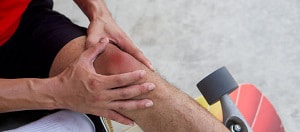As terrible as it may sound, injuries are part of a skateboarder’s journey. They could be due to lack of conditioning, poor execution, wrong skating spot, or other possible causes.
If you want to know more about these mishaps, let me introduce you to the worst skateboard injuries to help you prepare and avoid them. Hopefully, you won’t have to experience those biggest skateboard fails yourself.
Table of Contents
The Most Painful Skateboard Injuries
Perhaps, you thought of ankle sprains topping the list. Unfortunately, things could get worse than that. Here are a few nightmare injuries of skaters.
1. Head injury
Skateboarding head injuries can be on the skull or inside it. And they both come the head hitting hard or concrete surfaces. The only good thing about these skating injuries is that they may not be as lethal as those from motorcycle rides because of impact and speed differences.
Skull injuries are visible as head deformities, fractures, or cuts on the scalp.
If they’re not on the outside, falling from the skateboard head first may leave issues on the brain. These may be trauma, memory loss, fatigue, or headaches. Such problems can be more challenging to address unless there is thorough checking.
Most skateboarders who injure their heads skate without their helmets often.
2. Eye problems
Not everyone could imagine how damaged the eyes can get after falling off a skateboard. Besides a fracture in the skull, tumbling with your face towards the ground may leave scratches on your eyes.
Specifically, the cornea, retina, and eyeballs receive the most damage. And these casualties come from tiny objects like stones or ground particles sharp enough to harm the eyes.
These injuries are most probable with downhill skating, the reason riders opting for this style wear full-face helmets.
3. Shoulder injuries
We know how the shoulders assist us in gliding and balancing on the skateboard. Now imagine having dislocated collar bones and shoulder blades due to a bad fall.
Shoulder injuries occur when a skater slips or falls off a skateboard while defending the body by hand; this action displaces the shoulder’s joints in the process. Another possibility is that the shoulders themselves hit the ground with high impact.
These situations can cause the bones above the chest to break or lose firmness. What’s worse is the tissues and muscles also suffer.
4. Torso injury
Moving on, a skater’s ribs are also susceptible to injuries from skateboarding.
Like the skull, a person’s rib cage can also break after severe impact. Good if there’s no breakage, but hitting the ground from a mishap like skateboard scorpion with your torso can still leave bruises and tension on your upper body.
These situations worsen once the organs in the rib cage suffer hemorrhages.
5. Damaged elbows
Like the shoulders, the elbows assist the skater in diverting body weight from one side to another.
Elbows are one of the most vulnerable body parts when skating. And damage occurs once the skater falls off a skateboard and lands on the arms.
Consequently, a hard fall can cause the ligaments on the elbow to break. And if such a thing happens, the bones get displaced, and fractures occur.
6. Wrist injuries
Wrist pads do not come without a purpose.
Wrist injuries still affect at least a decent percentage of skaters today. Skateboarding accidents that involve the elbow or arm often hurt the wrist.
Specifically, some of the harms that can happen to a skater’s wrists include sprains, dislocations, fractures, and abrasions from ramps and sharp concrete surfaces.
7. Credit Carded Skateboarding Injury
This injury often happens with skaters landing from stairs with their skateboards waiting on the ground and positioned vertically against their crotch.
8. Knee fractures and dislocations
At first, I thought knee injuries were only frequent with volleyball or other sports like football. But seeing how many skaters on Reddit dealt with knee issues, I think it’s enough to say these are also rampant.
As they say, knee injuries happen to skaters who don’t wear knee pads. These problems could arise from bad landings after doing stunts on a mega ramp, resulting in a skateboarding big air crash.
And like the elbows, hard impacts can cause the knee ligaments to tear and bones to get fractured.
9. Ankle injuries
Damaged ankles can lower an athlete’s confidence to move and jump. Ankle injuries are similar to wrist harm, but the feet deal with the impact this time.
Landing on unstable ankles from a trick can cause the bones and ligaments inside to get damaged. This is why sneaker brands create shoes with ankle support.
How to Prevent Skateboarding Injuries
If you watched some Youtube videos, you would notice that the above injuries can occur at the same time and not separately. Fortunately, we can follow preventive measures to reduce their adverse effects.
1. Wear safety equipment
If we visit a skate shop, we don’t only see skateboards and skateboard parts displayed. Often, dedicated stores put safety equipment on sale. These pieces of equipment are as follows:
- Helmet for the head
- Wrist guards for the wrist and hands
- Elbow pads for the elbows and a portion of the arms
- Knee pads for the knees and knee caps
But before choosing your set of safety gear, always check for their durability, size, materials used, and certifications.
2. Avoid traffic
Skate parks are in almost every city. Though we understand some skaters prefer taking their boards to the streets, staying away from traffic remains a top precaution.
Especially with cars passing by, we don’t get much protection against a side sweep. So, always leave enough space between you and vehicles.
3. Don’t drink before skating.
Like drunk driving in cars, skating under the influence of alcohol is never a good idea. While bumping into some people might cause little to no injury, hitting a moving vehicle or a hard surface can land you in the hospital.
4. Choose less risky skating areas
Practice on smooth skating spots without rocks or other debris. Once you build that confidence, you can start skateboarding on rougher surfaces.
5. Don’t rush things
We can’t perform Aaron Jaws skateboarder teeth tricks overnight. Start with simple moves to harness your balance. From there, you can strengthen your legs and ankles and prepare them for much more challenging stunts.
What is the Most Common Skateboard Injury?
No one wants to cripple a body part in a skateboarding accident. Knowing the common injuries may help us avoid them.
Experts say that the most frequent injuries from skateboarding happen on the head, wrists, and ankles. And these come with repercussions like the need for operation, permanent disability, or skateboard death at worst.
How Many Deaths Have Been Caused by Skateboarding?
If we look at 2011-2015 U.S. skateboard injuries statistics, there have been more than 140 recorded deaths from skateboarding. These deaths come from accidents involving moving vehicles mostly.
What Are the Chances of Dying on a Skateboard?
The possibility of dying on a skateboard varies depending on factors like the skater’s speed, skating spot, or degree of impact from a mishap.
That said, around 40 people die due to skateboarding a year, so the chances are not very high.
When skating in a park, there is relatively no chance of death happening there. But things can get dreadful once you take your board to a busy street, where riding alongside vehicles is an absolute threat.
Conclusion
Injuries arising from doing sports are not inevitable. Instead, they aim to remind us to take safety precautions every time.
Not every day do we get all the luck when skating on the parks, streets, or hills. Sometimes, we can be victims of others’ actions on the road. With this discussion on the worst skateboard injuries, we hope we have awakened your mind to be more vigilant when skateboarding.
Always remember the preventive measures I shared to help you maintain a safe skating journey.

Hi, I am Charles Harris. I opened this site to write as much as I can about my biggest passion – skateboarding!
I started as a clumsy yet passionate rookie 10 years ago to now a still passionate yet much better skateboarder! But I have to tell you, the whole journey has always been fun and rewarding, indeed not without hardship.








